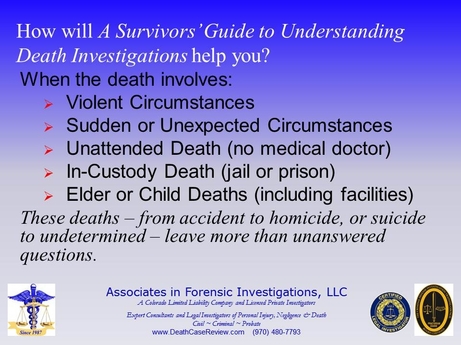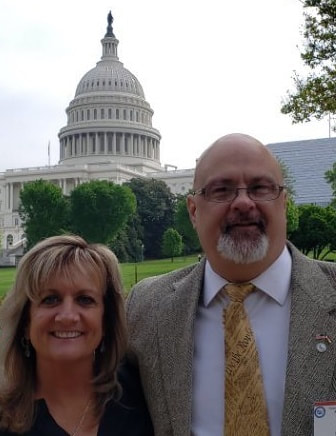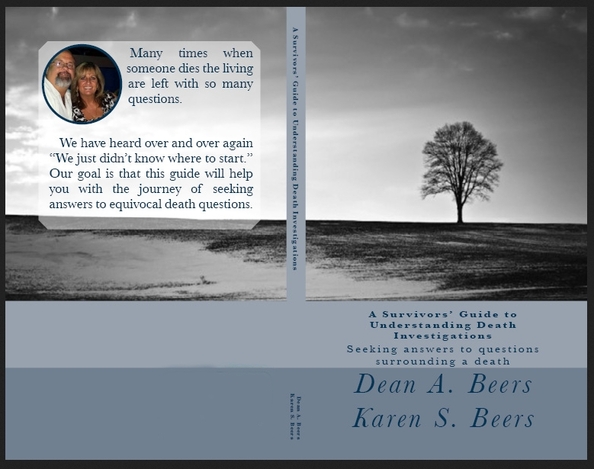
"Many times when someone dies the living are left with so many questions.
We have heard over and over again "We just didn't know where to start." Our goal is that this guide will help you with the journey of seeking answers to equivocal death questions."
From Associates in Forensic Investigations, LLC
We are pleased to announce the release of “A Survivors’ Guide to Understanding Death Investigations” – a book developed to help those who have lost a loved one to understand the maze, complexities and protocols of official death investigations.
We often hear from families, attorneys, investigators and funeral homes representing families, looking for where to turn in understanding how the death of a loved one was (or should have been) investigated. They seek closure through answers.
This “Survivors' Guide to Understanding Death Investigations” is a basic introduction, for the lay person, into the concepts of the official investigation of death, such as by a coroner or medical examiner office. It is our hope that understanding these concepts will help the process of healing and closure.
This guide is based upon extensive combined legal and death investigation experience. Specific to death investigation, this included responding to scenes and completing thorough independent investigations, and assisting with the autopsy. In addition, the most dreaded and responsible component of the process included the determination, location and notification of the decedent's next-of-kin.
This guide is intended to provide survivors some of the knowledge and insight to informatively and intelligently understand the concepts and protocols of death investigation, and the ability to ask the right questions. We hope this guide serves that purpose.
This guide is also ideal for the coroner and medical examiner offices, funeral homes, attorneys, investigators, and insurance companies who find themselves assisting families during this most tragic time of emotional confusion and need.
Associates in Forensic Investigations, LLC
Expert Consultants and Legal Investigators of Personal Injury, Negligence and Death in Civil, Criminal and Probate Deaths and Injury Causation.
Related commentary from our agency blog - "Proper Death Investigation Protocols Vital to Families"
It is important to understand that proper death investigation serves an important public health and safety purpose, as well as for the family – both closure and benefits. Some deaths may result in criminal charges, civil litigation, worker compensation claims, or life insurance benefits. There are two components to death investigation – Manner of Death and Cause of Death. The former is one of five classifications: Natural, Accident, Suicide, Homicide and Undetermined. The latter is specific to what disease process or injury and chain of events caused the death – such as cancer, asphyxiation, or drug overdose. Proper death investigation includes a scene investigation, scene assessment of the decedent, collection of evidence, review of medical and social history, and any additional background of the decedent and circumstances. A forensic autopsy is not performed for all deaths, only equivocal deaths in which clear and current medical history by an attending physician is not available.
Continued at http://www.deathcasereview.com/1/post/2013/06/proper-death-investigation-protocols-vital-to-families.html
We have heard over and over again "We just didn't know where to start." Our goal is that this guide will help you with the journey of seeking answers to equivocal death questions."
From Associates in Forensic Investigations, LLC
We are pleased to announce the release of “A Survivors’ Guide to Understanding Death Investigations” – a book developed to help those who have lost a loved one to understand the maze, complexities and protocols of official death investigations.
We often hear from families, attorneys, investigators and funeral homes representing families, looking for where to turn in understanding how the death of a loved one was (or should have been) investigated. They seek closure through answers.
This “Survivors' Guide to Understanding Death Investigations” is a basic introduction, for the lay person, into the concepts of the official investigation of death, such as by a coroner or medical examiner office. It is our hope that understanding these concepts will help the process of healing and closure.
This guide is based upon extensive combined legal and death investigation experience. Specific to death investigation, this included responding to scenes and completing thorough independent investigations, and assisting with the autopsy. In addition, the most dreaded and responsible component of the process included the determination, location and notification of the decedent's next-of-kin.
This guide is intended to provide survivors some of the knowledge and insight to informatively and intelligently understand the concepts and protocols of death investigation, and the ability to ask the right questions. We hope this guide serves that purpose.
This guide is also ideal for the coroner and medical examiner offices, funeral homes, attorneys, investigators, and insurance companies who find themselves assisting families during this most tragic time of emotional confusion and need.
Associates in Forensic Investigations, LLC
Expert Consultants and Legal Investigators of Personal Injury, Negligence and Death in Civil, Criminal and Probate Deaths and Injury Causation.
Related commentary from our agency blog - "Proper Death Investigation Protocols Vital to Families"
It is important to understand that proper death investigation serves an important public health and safety purpose, as well as for the family – both closure and benefits. Some deaths may result in criminal charges, civil litigation, worker compensation claims, or life insurance benefits. There are two components to death investigation – Manner of Death and Cause of Death. The former is one of five classifications: Natural, Accident, Suicide, Homicide and Undetermined. The latter is specific to what disease process or injury and chain of events caused the death – such as cancer, asphyxiation, or drug overdose. Proper death investigation includes a scene investigation, scene assessment of the decedent, collection of evidence, review of medical and social history, and any additional background of the decedent and circumstances. A forensic autopsy is not performed for all deaths, only equivocal deaths in which clear and current medical history by an attending physician is not available.
Continued at http://www.deathcasereview.com/1/post/2013/06/proper-death-investigation-protocols-vital-to-families.html

